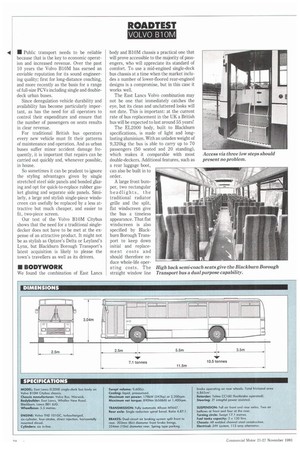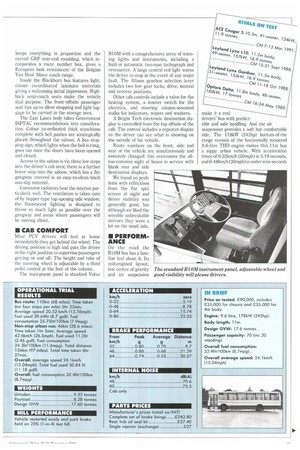• Public transport needs to be reliable because that is
Page 26

Page 27

If you've noticed an error in this article please click here to report it so we can fix it.
the key to economic operation and increased revenue. Over the past 10 years the Volvo B10M has earned an enviable reputation for its sound engineering quality; first for long-distance coaching, and more recently as the basis for a range of full-size PCVs including single and doubledeck urban buses.
Since deregulation vehicle durability and availability has become particularly important, as has the need for all operators to control their expenditure and ensure that the number of passengers on seats results in clear revenue.
For traditional British bus operators every new vehicle must fit their patterns of maintenance and operation. And as urban buses suffer minor accident damage frequently, it is important that repairs can be carried out quickly and, whenever possible, in house.
So sometimes it can be prudent to ignore the styling advantages given by single stretched steel side panels and bonded glazing and opt for quick-to-replace rubber gasket glazing and separate side panels. Similarly, a large and stylish single-piece windscreen can usefully be replaced by a less attractive but much cheaper, and easier to fit, two-piece screen.
Our test of the Volvo BI OM Citybus shows that the need for a traditional singledecker does not have to be met at the expense of an attractive product. It might not be as stylish as Optare's Delta or Leyland's Lynx, but Blackburn Borough Transport's latest acquisition is likely to please the town's travellers as well as its drivers. body and BlOM chassis a practical one that will prove accessible to the majority of passengers, who will appreciate its standard of comfort. To use a mid-engined single-deck bus chassis at a time when the market includes a number of lower-floored rear-engined designs is a compromise, but in this case it works well.
The East Lancs Volvo combination may not be one that immediately catches the eye, but its clean and uncluttered looks will not date. This is important: at the current rate of bus replacement in the UK a British bus will be expected to last around 55 years!
The EL2000 body, built to Blackburn specifications, is made of light and longlasting aluminium. With an unladen weight of 9,320kg the bus is able to carry up to 70 passengers (50 seated and 20 standing), which makes it comparable with most double-deckers. Additional features, such as a rear luggage boot, can also be built in to order.
A large front bumper, two rectangular headlights, the traditional radiator grille and the split, flat windscreen give the bus a timeless appearance. That flat windscreen is also specified by Blackburn Borough Transport to keep down initial and replacement costs and should therefore reduce whole-life operating costs. The straight window line keeps everything in proportion and the curved GRP rear-end moulding, which incorporates a route number box, gives a European look reminiscent of the Belgian Van Hool Alizee coach range.
Inside the Blackburn bus features light, colour co-ordinated laminate materials giving a welcoming initial impression. Highback semi-coach seats make the vehicle dual purpose. The front -offside passenger seat tips up to allow shopping and light luggage to be carried in the storage area.
The East Lanes body takes Government DiPTAC recommendations into consideration. Colour co-ordinated thick stanchions complete with bell pushes are strategically placed throughout the saloon. A bus stopping sign, which lights when the bell is rung, goes out once the doors have been opened and closed.
Access to the saloon is via three low steps into the driver's cab area; there is a further lower step into the saloon, which has a flat gangway covered in an easy-to-clean black non-slip material.
Convector radiators heat the interior particularly well. The ventilation is taken care of by hopper-type top opening side window; the fluorescent lighting is designed to throw as much light as possible over the gangway and areas where passengers will be moving about.
Most PCV drivers will feel at home immediately they get behind the wheel. The driving position is high and puts the driver in the right position to supervise passengers getting on and off. The height and rake of the steering wheel is adjustable by a third pedal control at the foot of the column.
The instrument panel is standard Volvo BI OM with a comprehensive array of warning lights and instruments, including a built-in automatic two-man tachograph and revcounter. A large central red light warns the driver to stop in the event of any major fault. The Allison gearbox selection lever includes two low gear locks, drive, neutral and reverse positions.
Other cab controls include a valve for the heating system, a master switch for the electrics, and steering column-mounted stalks for indicators, wipers and washers.
A Bright Tech electronic destination display is controlled from the top offside of the cab. The control includes a repeater display so the driver can see what is showing on the outside of his vehicle.
Route numbers on the front, side and rear of the vehicle are simultaneously and remotely changed: this overcomes the alltoo-common sight of buses in service with blank rear and side destination displays.
We found no problems with reflections from the flat split screen at night and driver visibility was generally good, but although we liked the sensible unbreakable mirrors they were a bit on the small side.




















































































